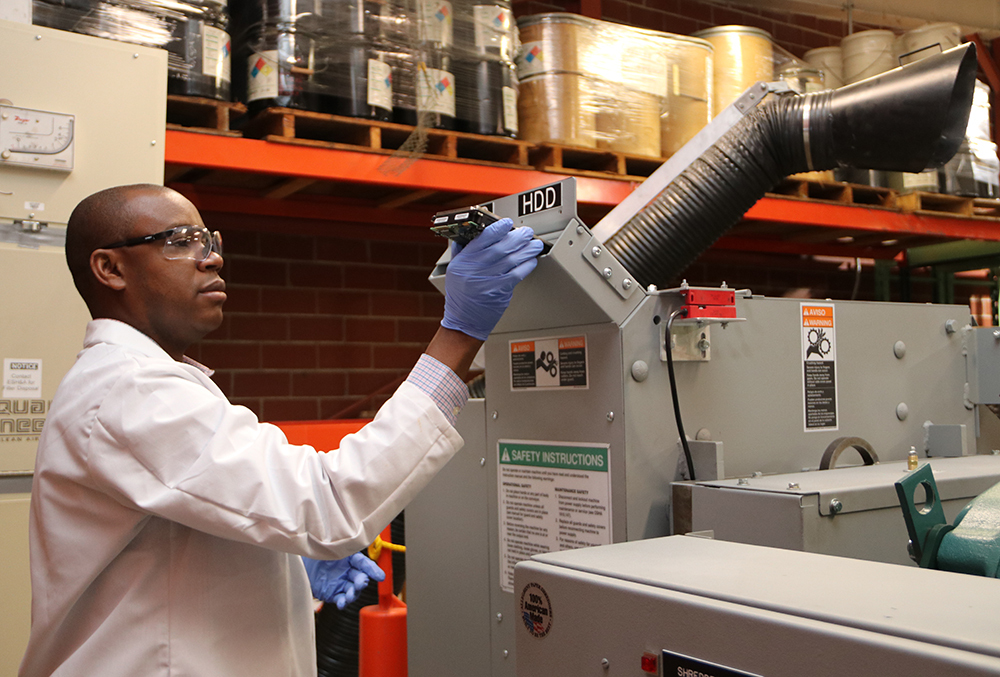See how ISU research is part of your everyday life at the Iowa State Fair
Author: Chelsea Davis, news service
This is an archived story. The content, links and information may have changed since the publication date.
Author: Chelsea Davis, news service

Ames National Laboratory scientist Ikenna Nlebedim loads a hard drive into a specialized shredder that turns obsolete technologies into a mound of pulverized scrap from which scientists can recover and reuse rare-earth metals. Photo courtesy of Ames National Laboratory.
Everyday items like your cell phone and future refrigerator are shaped by research conducted at the Ames National Laboratory.
Ames Lab will demonstrate its innovation in action at the Iowa State Fair as part of its 75th anniversary celebration. Ames Lab is the only U.S. Department of Energy national laboratory located on the campus of a major research university. It began as part of the Manhattan Project and was named a national laboratory by the Atomic Energy Commission (now the Department of Energy) in 1947.
Fairgoers will have an opportunity to learn how Ames Lab is tackling big challenges at Iowa State University's exhibit, "Innovation Revolution," in the Varied Industries Building.
The exhibit will include three interactive stations for attendees to learn how Ames Lab research is impactful in their daily lives, as well as to showcase research on the horizon. The exhibit is open 9 a.m.-8 p.m. every day of the fair, Aug. 11-21.
"When we make materials at Ames National Laboratory, our goal is to solve a problem," said Adam Schwartz, director of Ames Lab and professor of materials science and engineering. "How do we reduce the amount of lead in electronics? How do we address global plastic pollution? How do we make refrigeration systems better for the environment?
"We want Iowans to come away excited about the science that is happening right here in their state."
Lead-free solder, which joins together metals that would otherwise be joined by toxic lead, was invented at Ames Lab and patented in 1996. This safer, more environmentally friendly solder is now used in billions of computers, mobile devices and other electronics.
This section of the exhibit will showcase electronics in which lead-free solder is used.
Upcycling is the process of finding new and innovative uses for an item that would otherwise wind up in a landfill. Ames Lab scientists are developing new catalysts that turn discarded plastics into more valuable chemicals by breaking them down into precise components. These components form the building blocks for high-value chemicals that can be used in products like detergents and synthetic oils.
This station will feature a sculpture made from collected plastics, as well as a display of items that will one day be created through the upcycling process, including motor oil, shampoo, deodorant, makeup, sunscreen and soap.
Researchers also are working on ways to recycle critical materials from single-use items, including a new technology that efficiently recovers rare earths and other valuable elements from shredded computer hard drives. Visitors will see how hard drives are broken down through acid-free dissolution and used to create new materials.
The third station will highlight atomized metal powders, which are used in additive manufacturing, better known as 3D printing. The development of ideal metal powders for industry results in more efficient manufacturing systems, less material waste and more reliable product quality.
This station also will feature CaloriSMART, a one-of-a-kind system that uses magnetic forces to cool 20-25% more efficiently than current gas compression technology in refrigerators.
Visitors to the ISU exhibit also will see the CyHawk trophy and receive football posters and dry temporary tattoos.
The ISU Book Store will have a wide variety of Iowa State merchandise, gifts and apparel for sale, including Farm Strong T-shirts and gifts and new fall game-day gear.
Look for 4-H youth activities and exhibits in the Bruce L. Rastetter 4-H Exhibits Building, including 3,200 static exhibits and 750 communication performances. In addition, nearly 2,200 4-H youth will exhibit more than 9,000 livestock and horticulture entries in the livestock buildings and other agriculture venues. The colleges of Agriculture and Life Sciences and Liberal Arts and Sciences will award scholarships to selected 4-H'ers.
4-H is headquartered at Iowa State and available in all 99 counties.
4-H Day at the fair is Aug. 12; look for the 4-H Youth Development tent on the Grand Concourse. From 9 a.m. to 5 p.m., explore the 4-H priority areas through hands-on learning experiences. From 11 a.m. to 1 p.m., stop by the tent to receive a cooling towel. A full list of 4-H activities at the Iowa State Fair is online in CyBox.
Two veterinarians from the College of Veterinary Medicine will oversee the health of all animals at the fair. Doctors Rachel Friedrich and Megan Hindman are clinical assistant professors of veterinary diagnostic and production animal medicine. Assisting them will be fourth-year veterinary medicine students Melissa Garcia Rodriguez, Des Moines; Kelsey Gerwig, Winterset; Amberly Van Hulzen, Auburn; and McKenna Von Rentzell, Earlham.
The college will present Aug. 12 and 14 at the Advanced Vet Camp for students in grades 4-7, with Dave Gieseke, communications director for the college, serving as the featured speaker.
At the 40th annual Governor's Charity Steer Show on Aug. 13, College of Veterinary Medicine dean Dan Grooms will show a steer raised by Holland and Carson Rieck of Creston.